When Weschler started in 1941, panel meters were hand-made analog instruments. The typical meter had either a metal or bakelite case, a glass lens and an electro-mechanical movement. There were many US manufacturers during the 1940s and 1950s, including Triplett, Simpson, Weston, GE, Westinghouse, Beede, Hoyt, Hickok, Jewell, Marion, Supreme, and EMICO. Meters for DCV, DCA, ACV, ACA, and line frequency were standard. 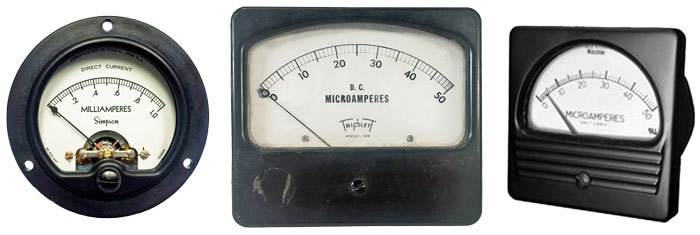 A few companies made elapsed time, temperature, watts, kWh, db, VU, RF and other specialty meters. Common sizes were 1½”, 2½”, or 3½” round, 2½” or 3½” square, and 3½” or 4½” rectangular. Analog meters could be customized with a mirrored scale, color zones, special ranges, custom dials and other features. Most manufacturers also private labeled meters for large customers.
A few companies made elapsed time, temperature, watts, kWh, db, VU, RF and other specialty meters. Common sizes were 1½”, 2½”, or 3½” round, 2½” or 3½” square, and 3½” or 4½” rectangular. Analog meters could be customized with a mirrored scale, color zones, special ranges, custom dials and other features. Most manufacturers also private labeled meters for large customers.
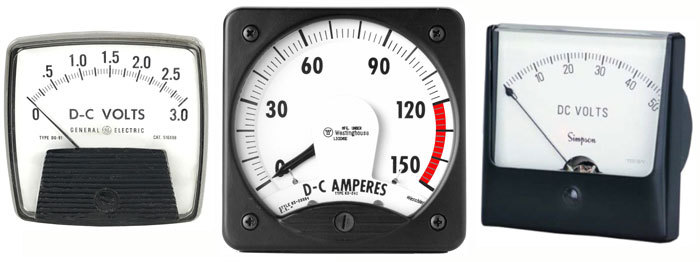 By 1960, new panel meters were introduced with polycarbonate fronts to reduce cost and provide a more modern look. Two examples are the GE Big Look (left) and the Simpson Wide View (right). Panel meter lines expanded to include additional sizes, offset zero models (such as 4-20mA), transformer rated AC ammeters, and shunt rated DC ammeters. The rugged Westinghouse switchboard meter (center) filled the need for long life in industrial control panels. GE made a similar line. High shock and ruggedized versions were developed for marine, military and mobile use. The number of domestic suppliers declined due to acquisitions and price competition.
By 1960, new panel meters were introduced with polycarbonate fronts to reduce cost and provide a more modern look. Two examples are the GE Big Look (left) and the Simpson Wide View (right). Panel meter lines expanded to include additional sizes, offset zero models (such as 4-20mA), transformer rated AC ammeters, and shunt rated DC ammeters. The rugged Westinghouse switchboard meter (center) filled the need for long life in industrial control panels. GE made a similar line. High shock and ruggedized versions were developed for marine, military and mobile use. The number of domestic suppliers declined due to acquisitions and price competition.
Digital panel meters (DPMs) began to appear in the 1970s. They offered increased resolution and accuracy. The input impedance was higher than analog meters, which resulted in a lower load on the signal being measured. Their operation required an external power source, which made retrofit difficult in some control panels. Initially, digital meters were more costly than the mature analog products, but the digital display was preferred in some applications. However, with the digital format, users often struggled to measure rapidly changing or noisy signals and spot trends.
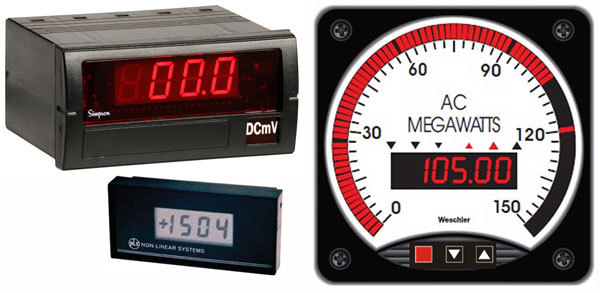 The typical digital panel meter of the 1980s had a 3½ or 4½ digit LED or LCD display (±2000 or ±20000 counts). Most DPMs were ordered with a fixed input range, but some could be rescaled in the field. General-duty meters had a plastic case. More rugged models used a metal housing with a plastic bezel. Microprocessor-based digital meters offered versatility – curve fitting, linearization, filtering, and other features. In addition to the standard electrical parameters, some digital meters could directly handle sensors, such as RTDs, thermocouples, load cells and speed (RPM) detectors. A digital meter with relay outputs performed the same function as an analog meter relay. A digital meter with analog process output could be used in place of a process transmitter. A simple serial interface (RS-232 or RS-485) enabled connection to a PC or minicomputer for data collection. One hybrid product, the digital bargraph meter (right), combined a precise digital readout with an LED bar display for quick level, setpoint and trend indication. Tri-color models changed the bar color, so users could immediately spot an over-limit or under-limit condition in a panel of meters.
The typical digital panel meter of the 1980s had a 3½ or 4½ digit LED or LCD display (±2000 or ±20000 counts). Most DPMs were ordered with a fixed input range, but some could be rescaled in the field. General-duty meters had a plastic case. More rugged models used a metal housing with a plastic bezel. Microprocessor-based digital meters offered versatility – curve fitting, linearization, filtering, and other features. In addition to the standard electrical parameters, some digital meters could directly handle sensors, such as RTDs, thermocouples, load cells and speed (RPM) detectors. A digital meter with relay outputs performed the same function as an analog meter relay. A digital meter with analog process output could be used in place of a process transmitter. A simple serial interface (RS-232 or RS-485) enabled connection to a PC or minicomputer for data collection. One hybrid product, the digital bargraph meter (right), combined a precise digital readout with an LED bar display for quick level, setpoint and trend indication. Tri-color models changed the bar color, so users could immediately spot an over-limit or under-limit condition in a panel of meters.
Despite more than 75 years of development, analog meter manufacturing was still labor-intensive. During the 80s and 90s, manufacturers added electronic circuits to some models to reduce mechanical complexity, lower cost and improve performance. At the same time, foreign suppliers entered the US market with lower-priced meters, to compete against US manufacturers and newer digital products. As a result, the number of US analog suppliers continued to decline. The two largest producers each sold their panel meter business, Westinghouse to Weschler and GE to Yokogawa. The addition of new digital suppliers, both domestic and foreign, greatly expanded the variety of available panel meters.
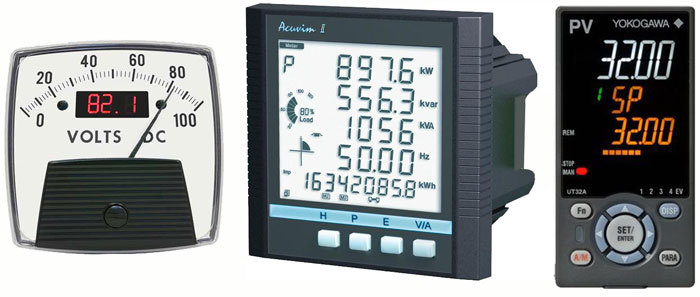 By 2000, in response to the demand for increased resolution and accuracy, manufacturers introduced 5½ and 6 digit DPMs. Millimeter dimensioned DIN cases became the standard for digital meters (1/4 DIN, 1/8 DIN, etc). Some analog manufacturers added a digital readout to their meters (left). Intelligent electronics and surface-mount components allowed suppliers to fit multiple functions and multiple readouts in a panel instrument (center). Ethernet and USB became popular communication options. Additional protocols such as Modbus TCP/IP, Profibus, and LONworks were introduced on some models. By including a real-time clock and non-volatile memory, a digital meter could function as a data logger. Digital meters with PID control functions and relay outputs were marketed as inexpensive process controllers (right).
By 2000, in response to the demand for increased resolution and accuracy, manufacturers introduced 5½ and 6 digit DPMs. Millimeter dimensioned DIN cases became the standard for digital meters (1/4 DIN, 1/8 DIN, etc). Some analog manufacturers added a digital readout to their meters (left). Intelligent electronics and surface-mount components allowed suppliers to fit multiple functions and multiple readouts in a panel instrument (center). Ethernet and USB became popular communication options. Additional protocols such as Modbus TCP/IP, Profibus, and LONworks were introduced on some models. By including a real-time clock and non-volatile memory, a digital meter could function as a data logger. Digital meters with PID control functions and relay outputs were marketed as inexpensive process controllers (right).
 Major developments for panel meters now focus on increased functionality, lower cost, graphical displays, and HMI. The three-phase power and energy meter (left) takes only 72x72mm of panel space. The switchboard power meter (center) has an icon-based touchscreen display. The multi-function graphics meter (right) can be programmed by the user to display a variety of meter styles.
Major developments for panel meters now focus on increased functionality, lower cost, graphical displays, and HMI. The three-phase power and energy meter (left) takes only 72x72mm of panel space. The switchboard power meter (center) has an icon-based touchscreen display. The multi-function graphics meter (right) can be programmed by the user to display a variety of meter styles.
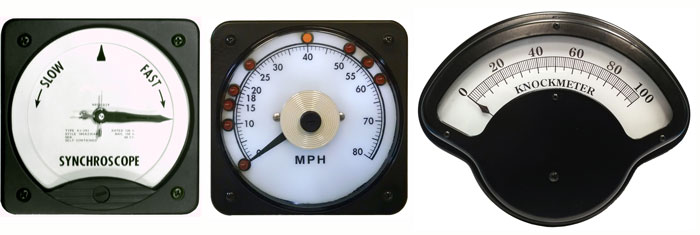 Even with the plethora of digital products on the market today, analog meters still fill many needs. Available products include standard models, like those pictured above, plus specialized meters for unique applications. Three are shown here: a synchroscope (left) with 360° needle rotation for AC generator synchronization, an illuminated speedometer with LED speed limit indicators (center) for locomotive dashboards, and the knockmeter (right) which was developed by Weston in the 1930s as part of an octane tester. All three of these meters are still made by Weschler. Weschler is also the only company making analog switchboard meters in the USA.
Even with the plethora of digital products on the market today, analog meters still fill many needs. Available products include standard models, like those pictured above, plus specialized meters for unique applications. Three are shown here: a synchroscope (left) with 360° needle rotation for AC generator synchronization, an illuminated speedometer with LED speed limit indicators (center) for locomotive dashboards, and the knockmeter (right) which was developed by Weston in the 1930s as part of an octane tester. All three of these meters are still made by Weschler. Weschler is also the only company making analog switchboard meters in the USA.
In summary, analog meter technology has been refined since Weschler Instruments started (as Weschler Electric) in 1941. Analog meters are available for commercial, industrial and military applications with various levels of performance. In the last 50 years, digital meter technology was invented, evolved, and continues to advance. The combination of analog and digital products leads to an almost overwhelming variety of panel instruments available to users today, from a worldwide list of manufacturers.
